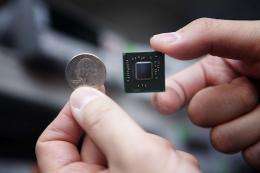Rosepoint chip combines CPU with WiFi. Credit: Intel
(Phys.org)—Justin Rattner, Chief Technology Officer at Intel, got up on stage at a recent Developer Forum sponsored by the company and talked about some of the communications technology it's working on; chiefly a chip it calls Rosepoint, a System on a Chip (SoC) that has a dual core Atom processor along with a WiFi radio transceiver. It's the culmination of ten years of research he told the audience, in trying to integrate digital processing with analog radio signals.
The presentation by Rattner made clear a major problem computer hardware makers are facing; as chips are made ever smaller, faster and less energy intensive, radio communications devices have lagged. Making them smaller causes them to work less well because they are analog based. They also tend to cause interference with other digital parts which has forced hardware makers to keep the different types of components separated. For Intel, this has been a problem that needed to be overcome as they made clear in their presentation that they believe the day will come when virtually every computer enabled device will need to talk wirelessly, with every other. What needed to happen, they said, was for radio to go all digital and that's what they've done. Rosepoint is, a "Moore's Law Radio" they say, a radio that can be made smaller without loss of signal strength.
To make a digital radio, Intel engineers had to go back to the very basics of how radio technology works and reinvent new ways to build each part; digital phase modulators, power amps, frequency synthesizers, etc. The last, one, the synthesizer, is the part that deals with interference, canceling it on the fly and preventing it from interfering with Atom digital processors.
None of the Intel speakers gave any indication as to when Rosepoint might begin showing up in actual products, but by showcasing the new technology, Intel has demonstrated their willingness to invest heavily in technology aimed mostly at handheld devices, an area where Intel has not been nearly as dominant as they have been in desktop and laptop computers.
The company also gave a few details about other projects it's working on, such as a way to allow laptops or ultrabooks to seem as always "on" as smartphones, a next generation wireless standard they call WiGig, and biometrics technology that hopefully will offer consumers a better way to protect themselves from those trying to gain access to their personal data, e.g. devices that read palm signatures rather than rely on passwords.
© 2012 Phys.org























